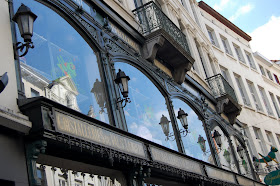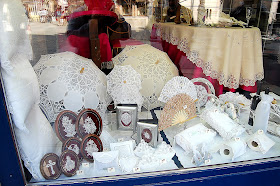
We left the Grand’ Place and the little streets around it and walked away on the cobblestones – a bicycle would have been nice…

I could not stop taking pictures of small alleys along the way.

Some cheerful music could be heard. We came closer and saw a trio enthusiastically playing for several “badauds” (idle pedestrians.)
This was more of a shopping area with a variety of shops: fashion, souvenirs, chocolate (of course), oriental pastries and more.

The shop below was especially nice. I don’t know what merchandise they sold because I was too enthralled by the architecture.

Below is a postcard showing some famous products of Belgium: chocolate, diamonds, beer, lace, mussels and “frites” (they don’t call them French fries there) and the statue of the little Manneken-Pis, a bronze fountain of a little boy.
 Postcard photograph courtesy Andrew Critchell
Postcard photograph courtesy Andrew CritchellIn the 15th century the Manneken-Pis was a fountain used to distribute drinking water. In the 18th century little Manneken-Pis was dressed four times a year. Now he has more than 800 suits I hear – 100 of them can be seen at the Museum of the City of Brussels. I bought postcards showing him as a Christmas helper, in judo clothes, as a western African nomadic Fula farmer (to mark World Milk Day) and with his little European suit.



As in Paris, I saw that Brussels does not destroy their old buildings. When they are crumbling inside they totally gut them but keep the historical façades. (In Atlanta they tend to most often destroy the whole building.)

Soon we were at the Galeries Royales Saint-Hubert, which is an early 19th century glazed shopping arcade. It has twin street-like courtyards under an arched-glass panel roof.

There are two sections called Galerie de la Reine (Queen’s Gallery) and Galerie du Roi (King’s Gallery) separated by a series of columns. It was inaugurated in June 1847 by King Leopold (1790-1865), first King of the Belgians. He was a Prince of Saxe-Coburg and Gotha and uncle of Queen Victoria.
Soon we were at the Galeries Royales Saint-Hubert, which is an early 19th century glazed shopping arcade. It has twin street-like courtyards under an arched-glass panel roof.


Since its inauguration the galleries have been offering luxury goods to Belgian shoppers. Below is a sample of some of the boutiques and restaurants there.

How about a pair of men shoes below? Only 375 Euros (US $550.)

We passed a frites maker (aka French fries in the US) but went on to have a beer in an old brasserie called Falstaff.

This “brasserie” which translates into brewery/pub was first a wine bar, back when it was established in 1903. Then it was remodeled by an interior decorator working for the famous Art Nouveau architect Baron Horta. It was still early afternoon before the “happy hour” so there were plenty of tables to choose from.

We decided to go into the back room close to the wonderful glass picture windows of Falstaff in the center with two other Breughel Flemish style picture windows on either side.

By the way, the name Falstaff comes from Sir John Falstoff (1378-1459), who was a British Knight and Captain during the Hundred Years War. It is said that Shakespeare based his fictional character of Sir Falstaff on him.

I may add that it was also pretty jolly to drink the refreshing “white” beer.

Actually it is called “biėre blanche” (white beer) in French. In Dutch it is called witbier and wheat beer in English. I had not tested it before but found it quite refreshing. Back in the car we drove around some more. Passing a large cathedral I asked that the car be stopped so I could take a better picture of it for my blogging friend Ginnie, of the blog In Soul from Holland.


It is Ginnie’s birthday today, Monday 13 June. She likes to visit historical churches and other places of worship, so since we did not go inside this cathedral, I found some pictures on the Internet (courtesy of Wikipedia) for her. This is the St Michael and St Gudula Cathedral. It is a Roman Catholic cathedral that has been used for major ceremonial events since 1312. The pulpit on the left is a wooden carving created by Hendrik F. Verbruggen in 1699. It depicts Adam and Eve being expelled from Eden.

Below are two historical prints, circa 1835. Happy Birthday Ginnie!

This concluded our first day in Brussels. We still have a second day to talk about and many opportunities for more pictures….


